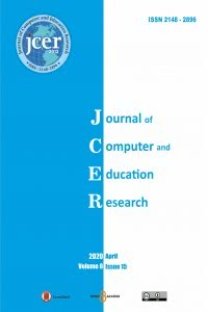Student Consultancy Service: Prediction of Course Grades in Course Selection Phases Using Artificial Intelligence Techniques
Student Consultancy Service: Prediction of Course Grades in Course Selection Phases Using Artificial Intelligence Techniques
___
- Aher, S., & L. M. R. J, L. (2012). A comparative study of association rule algorithms for course recommender system in e-learning. International Journal of Computer Applications, 48-52
- Babad, E. (2001). Students“course selection : differential considerations for first and last course students” course selection : Differential Considerations for First and Last Course, 42(4), 469–492. Retrieved from http://www.jstor.org/stable/30069473
- Babad, E., Icekson, T., & Yelinek, Y. (2008). Antecedents and correlates of course cancellation in a university “drop and add” period. Research in Higher Education, 49(4), 293–316. http://doi.org/10.1007/s11162-007-9082-3
- Babad, E., & Tayeb, A. (2003). Experimental analysis of students’ course selection. The British Journal of Educational Psychology, 73(Pt 3), 373–393. http://doi.org/Doi 10.1348/000709903322275894
- Babuška, R., & Verbruggen, H. (2003). Neuro-fuzzy methods for nonlinear system identification. Annual Reviews in Control, 27(1), 73–85. http://doi.org/10.1016/S1367- 5788(03)00009-9
- Baylari, A., & Montazer, G. a. (2009). Design a personalized e-learning system based on item response theory and artificial neural network approach. Expert Systems with Applications, 36(4), 8013–8021. http://doi.org/10.1016/j.eswa.2008.10.080
- Bozkir, A., Akcapinar Sezer, E., & Gök, B. (2009). Öğrenci seçme sınavında (öss) öğrenci başarımını etkileyen faktörlerin veri madenciliği yöntemleriyle tespiti. Uluslararası İleri Teknolojiler Sempozyumu (IATS’09)
- Caner, M. (2009). Estimation of specific energy factor in marble cutting process using ANFIS and ANN, 221–226.
- Güner, N., & Çomak, E. (2011). Mühendislik öğrencilerinin matematik i derslerindeki başarısının destek vektör makineleri kullanılarak tahmin edilmesi. Pamukkale Univ Muh Bilim Dergisi, 87-96
- Heaton, J. (2008). Introduction to neural networks for C# (2 edition). Heaton Research, Incorporated.
- Jang, J. (1993). ANFIS: adaptive-network-based fuzzy inference system. IEEE Transactions on Systems, Man, and Cybernetics, 23(3), 665–685. http://doi.org/10.1109/21.256541
- Jang, J. (1996). Input selection for ANFIS learning. Fuzzy Systems, Proceedings of the Fifth. 1493–1499. Retrieved from http://ieeexplore.ieee.org/xpls/abs_all.jsp?arnumber=552396
- Kalejaye, B., Folorunso, O., & Usman, O. (2015). Predicting students’ grade scores using training functions of artificial neural. Journal of Natural Science, Engineering and Technology
- Kardan, A. a., Sadeghi, H., Ghidary, S. S., & Sani, M. R. F. (2013). Prediction of student course selection in online higher education institutes using neural network. Computers & Education, 65, 1–11. http://doi.org/10.1016/j.compedu.2013.01.015
- Lo, J. J., Chan, Y. C., & Yeh, S. W. (2012). Designing an adaptive web-based learning system based on students’ cognitive styles identified online. Computers and Education, 58(1), 209–222. http://doi.org/10.1016/j.compedu.2011.08.018
- Lykourentzou, I., Giannoukos, I., Mpardis, G., Nikolopoulos, V., & Loumos, V. (2009). Early and dynamic student achievement prediction in E-learning courses using neural networks. Journal of the American Society for Information Science and Technology, 60(2), 372–380. http://doi.org/10.1002/asi.20970
- Lykourentzou, I., Giannoukos, I., Nikolopoulos, V., Mpardis, G., & Loumos, V. (2009). Dropout prediction in e-learning courses through the combination of machine learning techniques. Computers and Education, 53(3), 950–965. http://doi.org/10.1016/j.compedu.2009.05.010
- Najah, A. a., El-Shafie, A., Karim, O. a., & Jaafar, O. (2010). Water quality prediction model utilizing integrated wavelet-ANFIS model with cross-validation. Neural Computing and Applications, 21(5), 833–841. http://doi.org/10.1007/s00521-010-0486-1
- Naser, S., Zaqout, I., Ghosh, M., Atallah, R., & Alajrami, E. (2015). Predicting student performance using artificial neural network: in the faculty of engineering and information technology. International Journal of Hybrid Information Technology, 221-228
- Noureldin, A., El-Shafie, A., & Reda Taha, M. (2007). Optimizing neuro-fuzzy modules for data fusion of vehicular navigation systems using temporal cross-validation. Engineering Applications of Artificial Intelligence, 20(1), 49–61. http://doi.org/10.1016/j.engappai.2006.03.002
- Oladokun, V., Adebanjo, A., Sc, B., & Charles-Owaba, O. (2008). Predicting Students ’ academic performance using artificial neural network : a case study of an engineering course. The Pacific Journal of Science and Technology, 72-79
- Seber, G. A. F., & Lee Alan J. (2003). Linear regression analysis. Wiley-Interscience.
- Şahin, Ç., & Arcagök, S. (2013). İlköğretim öğretmenlerinin eğitim araştırmalarına yönelik yaklaşımları. Journal of Computer and Education Research, 1(2), 1-20.
- Şengür, D., & Tekin, A. (2013). Prediction of student’s grade point average by using the data mining methods. Bilişim Teknolojileri Dergisi, 6(3), 7-16.
- Şentürk, M. (2016). Sosyal bilgiler dersinde işbirlikli öğrenme yöntemlerinin akademik başarı üzerindeki etkisi. Journal of Computer and Education Research, 4(8), 205-221.
- Taylan, O., & Karagözoğlu, B. (2009). An adaptive neuro-fuzzy model for prediction of student’s academic performance. Computers & Industrial Engineering, , 732–741.
- Werbos, P. J. (1974). Beyond regression: new tools for prediction and analysis in the behavioral sciences foundations. Retrieved from http://www.citeulike.org/group/1938/article/1055600
- Yan, H., Zou, Z., & Wang, H. (2010). Adaptive neuro fuzzy inference system for classification of water quality status. Journal of Environmental Sciences, 22(12), 1891–1896. http://doi.org/10.1016/S1001-0742(09)60335-1
- Zacharis, N. (2016). Predicting student academic performance in blended learning using artificial neural. International Journal of Artificial Intelligence and Applications (IJAIA)
- Zaidah, I., & Daliela, R. (2007). Predicting students’ academic performance: comparing artificial neural network, decision tree and linear regression. 21st Annual SAS Malaysia Forum.
- Yayın Aralığı: 2
- Başlangıç: 2013
- Yayıncı: Tamer KUTLUCA
Sümeyye KAYNAK, Baran KAYNAK, Hayrettin EVİRGEN
Mehtap SARAÇOĞLU, Mustafa KAHYAOĞLU
Feyza Meryem KARA, Bülent GÜRBÜZ, Sonnur KÜÇÜK KILIÇ, Erman ÖNCÜ
Annaliina GYNNE, Marcus PERSSON
Baran KAYNAK, Sümeyye KAYNAK, Hayrettin EVİRGEN
Öğretmenlerinin Performans Görevlerine Bakışları: Hizmet İçi Eğitim Almış Zümre Başkanları Örneği
